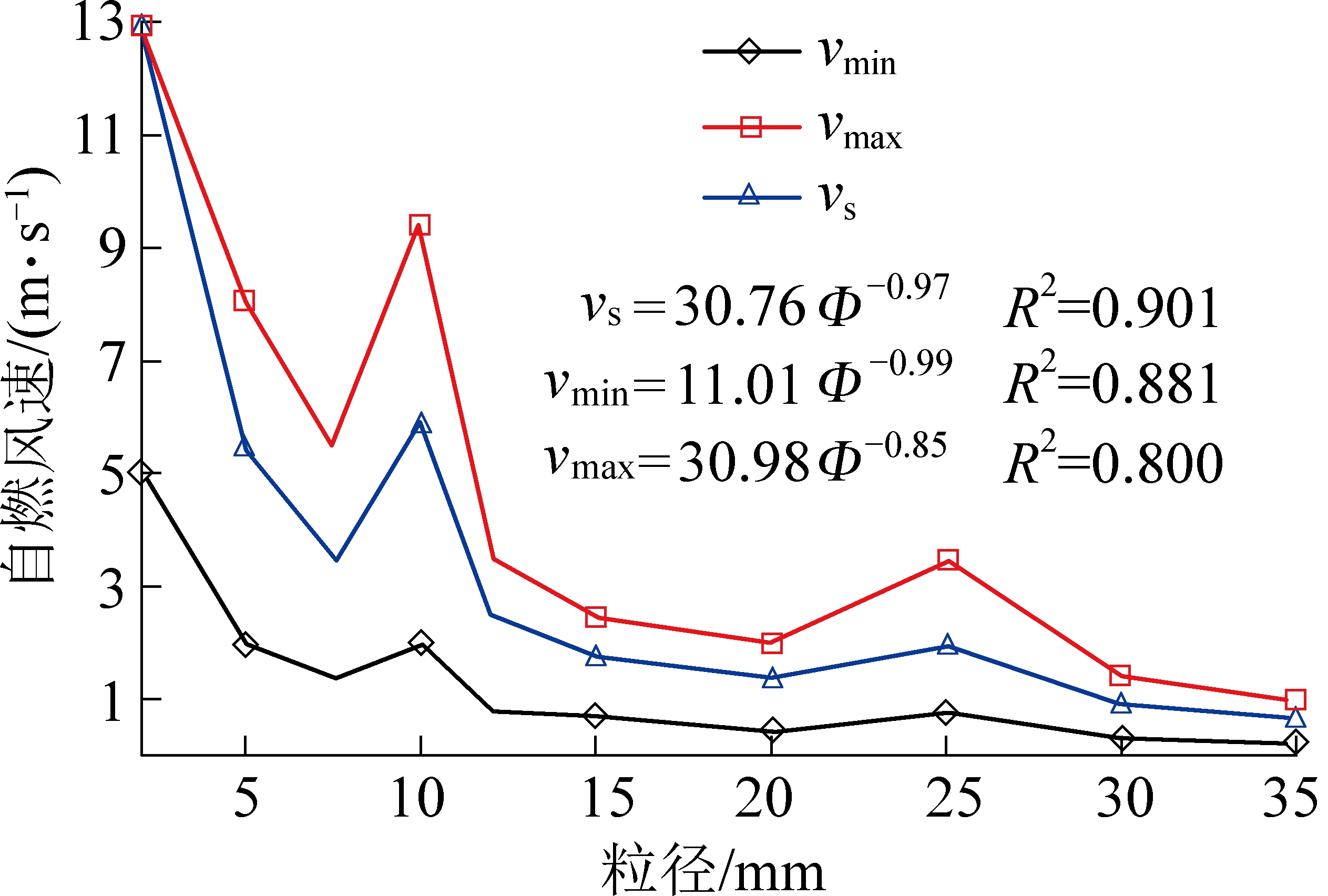0 引 言
我国煤炭行业产能严重过剩,许多煤矿存在相当长一段时间内大量原煤囤积的问题[1-2]。煤堆置于露天环境,在自然风流的作用下极易产生自热-自燃,释放大量的有毒有害气体,污染大气环境的同时,也存在重大的安全隐患[3-4]。因此,在不同风速条件下,对不同粒径煤堆的自热-自燃规律进行研究,可为现场防火提供参考与借鉴。
国内外许多学者针对煤堆自燃问题进行了较为系统的研究,主要集中在试验测试、数值模拟、现场参数采集分析等煤体自燃方面研究,并取得了许多成果。邓军等[5]进行了煤自燃防灭火热棒移热降温性能试验,通过破坏煤堆内部蓄势环境有效降低煤自然发火的危险性;李树刚等[6]利用现场实测和实验室试验,对地面储煤堆自燃规律进行试验研究,并研制出可伸缩深基点测温仪表;张春等[7]通过建立综放采空区遗煤自燃的三维数值模型,对采空区遗煤自燃过程进行数值模拟研究;刘星魁等[8-9]建立了二维干燥煤堆传热传质数学模型,对煤堆自燃升温规律与漏风特征进行数值模拟分析;文献[10]采用二维非稳态计算模型,从煤堆的堆放时间、高度、粒径、角度、孔隙率等因素进行自热-自燃分析;文献[11-12]对不同水分的煤样进行自燃试验研究,给出不同含水煤自燃热特性比对曲线;文献[13-14]对煤的低温条件下的自燃特性和传热进行对比试验研究;陆新晓等[15]针对氧化煤在复燃过程中的自燃倾向特征进行试验研究,确定了不同氧化过程煤的复燃规律;黎经雷等[16]从风速对空区遗煤自燃的影响开展研究,对不同风速下采空区流场进行模拟分析,给出了不风速条件下采空区氧化带面积变化曲线和计算公式。针对煤堆的自燃问题,在诸多的影响因素中,以煤堆粒径、环境风速、孔隙率等最为显著。目前,对于煤堆自燃开展的研究较多,但针对煤堆粒径对煤堆自热-自燃风速的影响,及不同粒径条件下煤堆自燃的风速范围研究不够深入。
文中煤堆研究背景依托内蒙古西部矿区,根据研究地区气象条件[17],考虑到煤堆除了受自燃风速的影响外,还受到周围建筑结构、地形等因素的影响。结合研究效果的延展性,笔者以COMSOL为数值分析手段,确定在环境风速为0.05~13.00 m/s条件下建立多孔介质间流动、传热、传质的耦合模型,研究煤堆平均粒径0.50~35.00 mm对煤堆自燃风速范围规律,为煤堆自热-自燃的防治提供借鉴与参考。
1 煤堆自燃数学模型的建立
1.1 数学模型的建立
1.1.1 自由与多孔介质流动
假设煤堆为球形颗粒介质堆积而成的多孔介质结构,鉴于颗粒介质堆积状况的多样性,取孔隙率n分别为0.2、0.3、0.4、0.5、0.6。则煤堆的渗透率控制方程由平均粒径和孔隙率共同决定[18-19],为
(1)
式中:kp为渗透率,m2;Φ为煤堆平均粒径,m。
鉴于煤堆在自热-自燃过程中煤氧复合作用,导致煤温升高,进而在煤堆中形成体积力或上浮力。这个热浮力也称为火风压,用式(2)表示[20]
(2)
式中:hf为热浮力,Pa,ρ0为风流密度初始密度,kg/m3;g为重力加速度,m/s2;y为区域高度,m;T0为煤堆初始温度或环境温度,K;Ty为煤堆温度,K。
1.1.2 煤堆内部传质过程
煤堆内部在煤氧复合作用下产生氧化放热,整个过程分为低温氧化、高温氧化2个阶段。伴随着氧化升温的进度,煤堆内部质的传递与扩散,耗氧速率、氧气扩散系数分别用式(3)、式(4)表示[21]

(3)
式中:rO2为耗氧速率,mol/(m3·s);rO21为低温阶段的耗氧速率,mol/(m3·s);rO22为高温阶段的耗氧速率,mol/(m3·s);cO2为氧气体积分数,mol/m3;cO20为初始氧气体积分数,mol/m3。
(4)
式中:DO2为氧气扩散系数,m2/s;DO20为初始状态的氧气扩散系数,3.5×10-5 m2/s;P0为煤堆初始气压,Pa;P2为煤堆内适时气压,Pa。
1.1.3 煤堆内部传热过程
煤堆在煤氧复合作用下对应不同氧化阶段的耗氧放热量用式(5)表示,煤体导热系数随温度的变化用式(6)表示[22]

(5)
λT=0.000 63Ty+0.110 7
(6)
式中:λT为煤堆的导热系数,J/(m·K)。
1.2 边界条件的确定
煤堆以外的区域设置为自由流体。煤堆内部整个研究区域均为自由和多孔介质,且左侧边界设置为风流入口,右侧边界设置为风流出口,入口采用风速(vin)控制,出口采用自由与多孔介质流动方程的压力控制。煤堆顶部边界以及迎风坡和背风坡为环境煤堆与外界环境的交界面,设置为氧气浓度边界,氧气体积分数21%(9.375 mol/m3)。煤堆顶部边界和两坡面为对流热通量控制边界,顶部边界的对流传热系数为4.1 W/(m2·K),两坡面为1.51 W/(m2·K)。
2 数值模拟与结果分析
2.1 物理模型
煤堆高H=6 m,底部宽度Lx=24 m,顶部宽度Ls=12 m,煤堆堆放角度正切值为H/x=1,煤堆底部中心点位于计算区域的中间位置100 m处的物理模型,如图1所示。

vin为煤堆的迎面速度,即模拟中的入口风速
图1 物理模型
Fig.1 Physical Model
2.2 初始条件的确定
模型求解初始条件如下:

相对湿度/%75初始温度/K293空气密度/(kg·m-3)1.25初始大气压/MPa0.101 32初始水分/%3.5初始氧体积分数/%21最短自然发火期/d45~60
笔者主要考虑煤堆粒径及风速对煤堆自燃的影响。
2.3 结果分析
2.3.1 粒径对煤堆最高温度的影响
煤堆平均粒径的不同,其内部渗透性及孔隙结构也不同,进而导致煤堆在自热-自燃过程中的表征也不同。不同风速条件下对应不同粒径煤堆最高温度变化规律,如图2所示。平均粒径为0.5~35.0 mm的煤堆在不同风速(0.05~13.00 m/s)变化下最高温度变化情况,如图2a所示。除Φ=0.5、2 mm的煤堆外,其他煤堆均呈随风速增加内部最高温度具有“快速增加—达到最大值—快速下降—稳定在一个相对较低值”的过程。不过,随煤堆粒径的不同其温升、温降的速率表现不同,较高风速条件下所能达到的稳定温度也不同。由图2a可知:当vin>7 m/s后,小粒径(Φ≤10 mm)的煤堆的温度一般大于大粒径(Φ>10 mm)的煤堆。
因此,采用细煤覆盖进行煤堆保护时必须与压实一样,应充分考虑煤堆外部风速,否则会起到相反作用。
由图2b可知:在0.05~1.00 m/s低风速范围内煤堆的平均粒径越大煤堆随风速增加升温速率越快。其中Φ>20 mm的煤堆最高温度随风速增加在0.5~1.0 m/s基本达到最高温度Tmax。在0.05~1.00 m/s的风速范围内,煤堆平均粒径越小其内部最高温度Tmax越低。
因此,当风速在0.05~1.00 m/s采用细煤掺混或覆盖能起到较好的保护作用。
由图2c可知:Φ≥15 mm的煤堆在风速1~3 m/s范围内开始出现温度快速降低的现象;Φ<15 mm的粒径煤堆温度则仍沿续随风速的增加温度持续升高的规律。在1~3 m/s风速范围内煤堆温度相对较高的是粒径分别为:25、7.5、12、10、5 mm的煤堆,即温度较高的煤堆以Φ =10±2 mm为主。
因此,在1~3 m/s风速范围使用细煤进行煤堆保护应依据具体情况决定。
由图2d可知:在3~13 m/s风速范围内,随风速增加,Φ>2 mm的粒径煤堆最高温度呈持续降低趋势;φ=2、0.5 mm的煤堆则表现出相反趋势。且小粒径(Φ≤10 mm)煤堆温度明显高于大粒径(Φ>10 mm)煤堆温度。

图2 不同风速时不同粒径煤堆最高温度变化规律
Fig.2 Variation law of the maximum temperature of different particle size coal with different wind speed
因此,采用细煤掺混或覆盖技术保护煤堆时必须严格依据外界风速进行设计,当风速vin>2 m/s时不宜单独采用细煤覆盖技术,应当首先采取相关措施控制煤堆周围风速,风速控制在vin<1 m/s时再配合使用细煤覆盖技术。
2.3.2 粒径对煤堆自燃风速范围的影响
粒径不同的煤堆,自燃风速范围也不同,在自燃风速范围内煤堆最短自然发火期也同样存在较大差异。不同自燃风速下,不同粒径煤堆的最短自然发火期变化如图3所示。
由图3可知:在自燃风速范围内,对于不同粒径的煤堆而言,最小自燃风速对应的最短自然发火期最长,随着风速增加自然发火期快速变短,之后随风速增加自然发火期又开始延长。即随着自燃风速的增加,煤堆的自然发火期呈现“先快降—慢降—慢升—快升”趋势。

图3 不同粒径煤堆自燃风速范围及最短自然发火期
Fig.3 Range of spontaneous combustion and the shortest period of coal spontaneous combustion in different particle sizes
随平均粒径的增加煤堆自燃风速范围在逐渐收窄(表1),同时,煤堆自燃的最小风速vmin和最大风速vmax也随着粒径的增加而逐渐降低;从易自燃风速上看:煤堆粒径越大,最易自燃风速越低。对于不同粒径下煤堆自燃风速与最短自然发火期之间的关系见表2。
表1 不同粒径对应煤堆的自燃风速范围及易自燃风速
Table 1 Different particle size corresponds to the range of spontaneous combustion wind speed and easy spontaneous combustion wind speed of coal pile

粒径/mm自燃风速/(m·s-1)vminvmax最易自燃风速/(m·s-1)2.05.0013.013.05.02.008.05.57.51.405.53.510.02.006.06.012.00.803.52.515.00.702.51.820.00.402.01.425.00.803.52.030.00.301.41.035.00.251.00.7
表2 不同粒径下煤堆自燃风速与最短自然发火期的关系
Table 2 Relationship between spontaneous combustion velocity and the shortest spontaneous ignition period in coal pile with different particle size

粒径/mm关系表达式拟合优度 R22.0t=949.960-370.577vin+57.570vin 2-3.907vin 3 +0.097 6vin 40.985 485.0t=433.180-303.264vin+91.739vin 2-12.052vin 3 +0.581 5vin 40.922 307.5t=348.525-345.974vin+156.706vin 2-31.080vin 3 +2.276 0vin 40.968 0910.0t=335.718-199.195vin+53.556vin 2-6.264vin 3 +0.268 6vin 40.948 6212.0t=512.761-906.221vin+667.614vin 2-212.099vin 3 +24.591 6vin 40.902 5815.0t=484.161-1 121.340vin+1 099.402vin 2-464.582vin 3 +71.248 7vin 40.953 3820.0t=615.634-1 999.020vin+2 603.691vin 2-1 432.210vin 3 +282.173 3vin 40.802 3925.0t=393.591-636.669vin+444.127vin 2-132.064vin 3 +14.178 2vin 40.966 7230.0t=512.631-2 354.9vin+4 546.566vin 2-3 767.67vin 3 +1 125.198vin 40.974 5335.0t=510.246-2 686.530vin+5 998.609vin 2-5 828.14vin 3 +2 076.625vin 40.982 88
2.3.3 粒径对最小、最易、最大自燃风速影响
不同粒径煤堆的最小vmin、最大vmax、最易vs自燃风速随着煤堆粒径的增大呈快速下降,最终趋于一个稳定值,如图4所示。由图4可知:当风速vin<2 m/s时,煤堆可以采用细煤掺混或表面覆盖一定厚度和高度的细煤。这样就可提高煤堆自燃的风速,在低风速环境下不易发生自燃;在风速vin>3.5 m/s时,如果降低煤堆平均粒径会导致在自燃风速范围内煤堆的自燃。在不同粒径煤堆条件下,最小、最大、最易自燃风速与粒径均呈幂函数关系。

图4 煤堆最小、最大、最易自燃风速随煤堆粒径的变化规律
Fig.4 Minimum,maximum,and most suitable combustion wind speed of different particle size coal
3 结 论
1)建立了基于不同风速条件下的不同粒径煤堆的自热-自燃耦合模型,提出了不同粒径煤堆下对应的自燃风速和最短自然发火期的拟合关系式以及最易自燃、最小自燃、最大自燃风速关系式,为煤堆高效自燃防治提供依据。
2)通过数值模拟分析,得出了不同煤堆粒径的自燃风速范围。平均粒径分别2、5、7.5、10、12、15、20、25、30、35 mm的自燃风速范围分别是5~13、2~8、1.4~5.5、2~6、0.8~3.5、0.7~2.5、0.4~2、0.8~3.5、0.3~1.4、0.25~1.00 m/s。表明随煤堆平均粒径的增加,煤堆自燃风速范围变窄,对应于上述粒径煤堆最易自燃风速分别为13、5.5、3.5、6、2.5、1.8、1.4、2、1、0.7 m/s;同时,可以引起自燃的最小、最易、最大自燃风速随煤堆粒径增加逐而降低。
3)当煤堆的平均粒径为0.5 mm时,风速在0.05~13.00 m/s内,煤堆一般不能发生自燃现象。当煤堆粒径不小于1 mm时,在不同风速范围内均存在着不同程度的自燃现象。当煤堆平均粒径Φ≤10 mm,在风速vin≤1 m/s时,粒径越小,煤堆最高温度越低;当风速vin>1 m/s时,粒径越小,煤堆的温度越高。
[1] 陈胜华,焦希颖,胡振琪,等.自燃煤矸石山覆盖材料压缩及压实特性实验[J].环境工程学报,2013,7(11):4540-4546.
CHEN Shenghua,JIAO Xiying,HU Zhenqi,et al.Experiment on compression and compaction characteristics of materials for covering coal gangue piles[J].Chinese Journal of Environmental Engineering,2013,7(11):4540-4546.
[2] 张玉涛,李亚清,邓 军,等.煤炭自燃灾变过程突变特性研究[J].中国安全科学学报,2015,25(1):78-83.
ZHANG Yutao,LI Yaqing,DENG Jun,et al.Study on catastrophe of coal spontaneous combustion[J].China Safety Science Journal,2015,25(1):78-83.
[3] 张瑞新,谢和平.煤堆自然发火的试验研究[J].煤炭学报,2001,26(2):168-171.
ZHANG Ruixin,XIE Heping.Experimental study of the propensity of coal stockpiles to spontaneous combustion[J].Journal of China Coal Society,2001,26(2):168-171.
[4] 段文波,王普毅,刘金龙.露天煤矿煤的自燃与储煤管理[J].露天采矿技术,2015(2):81-83.
DUAN Wenbo,WANG Puyi,LIU Jinlong.Coal spontaneous combustion and storage coal yard management in open-pit coal mine[J].Opencast Mining Technology,2015(2):81-83.
[5] 邓 军,李 贝,马 砺.用热棒技术强化煤堆降温幅度试验[J].中国安全科学学报,2015,25(6):62-67.
DENG Jun,LI Bei,MA Li.Influence of heat pipes on temperature distribution in coal storage pile[J].China Safety Science Journal,2015,25(6):62-67.
[6] 李树刚,徐精彩.地面储煤堆自燃规律的实验研究[J].辽宁工程技术大学学报(自然科学版),2000,19(3):229-231.
LI Shugang,XU Jingcai.Experimental study of spontaneous combustion rule of ground coal storage pile[J].Journal of Liaoning Technical University(Natural Science),2000,19(3):229-231.
[7] 张 春,题正义,李宗翔.综放采空区遗煤自燃的三维数值模拟研究[J].中国安全科学学报,2013,23(5):15-21.
ZHANG Chun,TI Zhengyi,LI Zongxiang.Three-dimension numerical simulation of residual coal spontaneous combustion in golf in fully mechanized caving face[J].China Safety Science Journal,2013,23(5):15-21.
[8] 刘星魁,王公忠.干燥煤堆自燃升温特征的数值模拟[J].湖南科技大学学报(自然科学版),2015,30(3):7-12.
LIU Xingkui,WANG Gongzhong.The numerical simulation of spontaneous combustion heating up regulation in dry coal pile[J].Journal of Hunan University of Science & Technology(Natural Science Edition),2015,30(3):7-12.
[9] 刘星魁,杨书召.煤堆自燃升温规律与漏风特征的数值模拟[J].河南理工大学学报(自然科学版),2015,34(5):610-614.
LIU Xingkui,YANG Shuzhao.Numerical simulation of heating up and air leakage distribution for spontaneous combustion of coal pile[J].Journal of Henan Polytechnic University(Natural Science),2015,34(5):610-614.
[10] KGUNA F A,ESSENHIGH R H.Self-ignition characteristics of coal stockpiles:theoretical prediction from a two-dimensional unsteady-state model[J].Fuel,2001,80:409-415.
[11] 秦波涛,仲晓星,王德明,等.煤自燃过程特性及防治技术研究进展[J].煤炭科学技术,2021,49(1):66-99.
QIN Botao,ZHONG Xiaoxing,WANG Deming,et al.Research progress of coal spontaneous combustion process characteristics and prevention technology[J].Coal Science and Technology,2021,49(1):66-99.
[12] 贾廷贵,娄和壮,刘 剑,等.不同水分含量煤自燃过程热特性实验研究[J].煤炭学报,2020,48(2):110-117.
JIA Tinggui,LOU Hezhuang,LIU Jian,et al.Experimental study on thermal characteristics of spontaneous combustion process of coal with different moistrue[J].Coal Science and Technology,2020,48(2):110-117.
[13] 邓 军,任帅京,肖 旸,等.煤低温氧化与热解过程的传热特性对比研究[J].煤炭学报,2019,44(1):171-177.
DENG Jun,REN Shuaijing,XIAO Yang,et al.Comparative study on heat transfer characteristics of coal during low temperature oxidation and pyrolysis[J].Journal of China Coal Society,2019,44(1):171-177.
[14] 马 砺,李超华,武瑞龙,等.最低点火温度条件下煤粉自燃特性试验研究[J].煤炭科学技术,2020,48(2):110-117.
MA Li,LI Chaohua,WU Ruilong,et al.Experimental study on spontaneous combustion characteristics of pulverized coal under minimum ignition temperature[J].Coal Science and Technology,2020,48(2):110-117.
[15] 陆新晓,赵鸿儒,朱红青,等.氧化煤复燃过程自燃倾向性特征规律[J].煤炭学报,2018,43(10):2809-2816.
LU Xinxiao,ZHAO Hongru,ZHU Hongqing,et al.Characteristic rule of spontaneous combustion tendency of oxidized coal at recrudescence stage[J].Journal of China Coal Society,2018,43(10):2809-2816.
[16] 黎经雷,牛会永,鲁 义,等.风速对近距离煤层采空区漏风及煤自燃影响研究[J].煤炭科学技术,2019,47(3):156-162.
LI Jinglei,NIU Huiyong,LU Yi,et al.Study on effect of wind speed to air leakage and spontaneous combustion in goaf of contiguous seams[J].Coal Science and Technology,2019,47(3):156-162.
[17] 郭春燕.近50年内蒙古自治区风速变化周期及突变分析[J].干旱区资源与环境,2015,29(9):154-158.
GUO Chunyan.Analysis of wind speed wariation period and abrupt change in Inner Mongolia over the past 50 years[J].Journal of Arid Land Resources and Environment,2015,29(9):154-158.
[18] ALAZMI B,VAFAI K.Analysis of variants within the porous media transport models[J].Heat Transfer,2000,122:303-325.
[19] EJLALI A,KAMEL HOOMAN,BASIL BEAMISH.Effects of porosity changes on the self-heating characteristics of coal stockpiles[J].Journal of Porous Media,2012,15(9):869-876.
[20] 杨永良.煤最短自然发火期测试及煤堆自燃防治技术研究[D].徐州:中国矿业大学,2009.
[21] 王文才,王鑫宙,张根源,等.煤田露头火区温度场模拟分析和火风压计算[J].煤炭技术,2016,35(3):126-128.
WANG Wencai,WANG Xinzhou,ZHANG Genyuan, et al.Temperature simulation of coal outcrop fire area and calculation of fire wind pressure[J].Coal Technology,2016,35(3):126-128.
[22] RIBEIRD J,FERREIRA DA SILVA E,LI Z,et al.Petrographic,mineralogical and geochemical characterization of the Serrinha coal waste pile Douro Coalfield,Portugal and the potential environmental impacts on soil,sediments and surface waters[J].International Journal of Coal Geology,2010,83:456-466.
